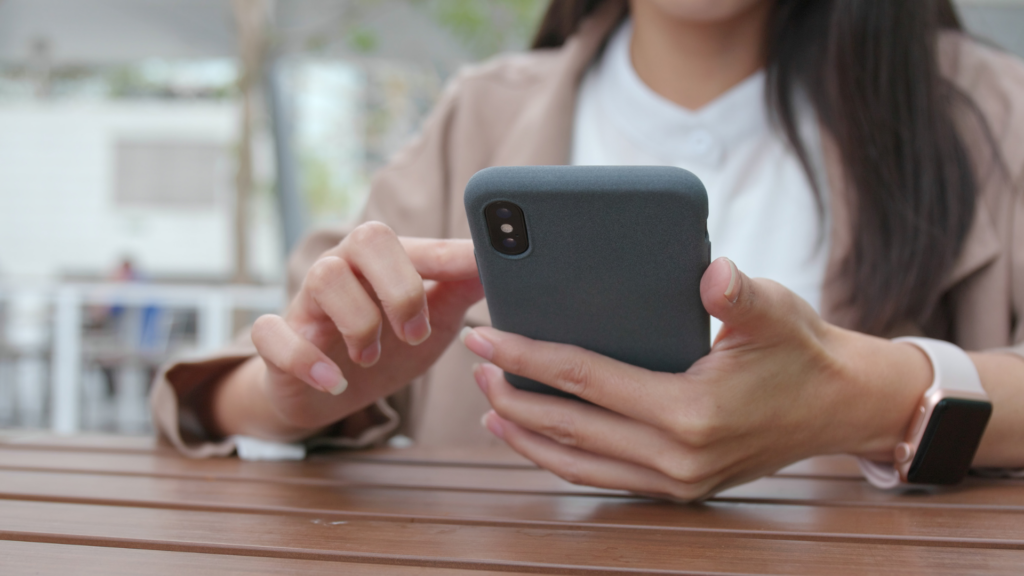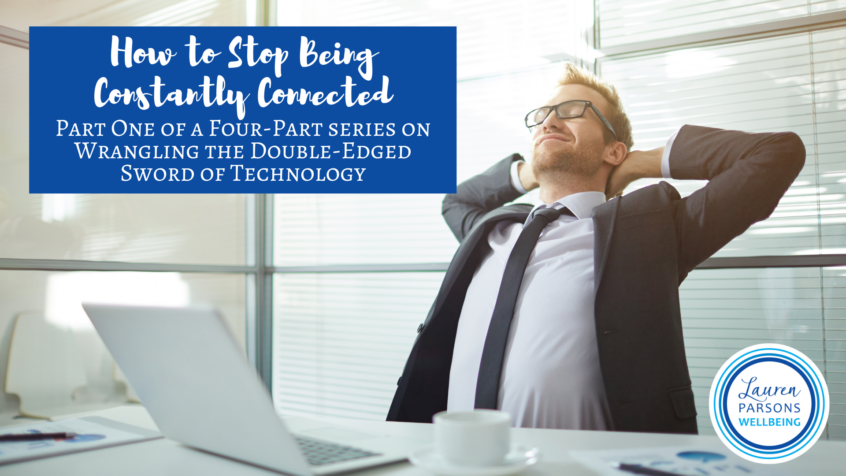An excerpt from Lauren Parsons’ book ‘Thriving Leaders Thriving Teams’.
Technology has drastically changed the way we live, play, move, breathe and work. Many of the advancements are fantastic. They simplify and speed up processes, make us easy to contact, and keep us informed and in touch with loved ones. However, technology is a double-edged sword, with serious negative impacts for our wellbeing, relationships and productivity when not wielded correctly.
With working from home on the rise, the reliance on technology is even greater. Back-to-back online meetings can be draining and heighten anxiety; people are in ‘performance’ mode, watching themselves on the screen. Many also suffer from feeling isolated and disconnected, missing the workplace banter and the human interaction almost all crave. Even introverts need some human connection; the lack of smiling faces and friendly laughs takes its toll.
Well before the working-from-home trend, many people were already so heavily addicted to devices and social media that it seriously affected their wellbeing.
Technology is making us:
- Constantly accessible. (today’s topic)
- Less connected.
- More distracted.
- Overloaded with information. (coming soon)
Let’s look at the first one of these challenges and unpack some practical ways to overcome it.
Challenge #1 – Constantly Accessible
Today, most people have their smart phone with them virtually all the time. We’re constantly connected to the online world, something that wasn’t possible two decades ago.
People check their phone an average of 352 times a day. That’s more than every three minutes. 44% of people feel anxiety when separated from their phone and 75% of people even admit to using their phones in the bathroom.
A 2022 study showed that, worldwide, people spend an average of 2 hours 27 minutes a day on social media. Many people are enslaved by their phones, checking messages constantly throughout the day (and sometimes the night).
Linda Stone, who worked on emerging technologies at both Apple and Microsoft, coined the term ‘continuous partial attention’ in 1997 to describe the state of always being partly tuned into everything while never being completely tuned in to any one thing. Those three words are an apt description of how most of us go through life.
This never-ending connection doesn’t give you time to switch off. It’s when we pause and do nothing that the super-computer in our brain kicks into high gear. This is why we often have our best ideas in the shower or when out for a walk. When your body is active and your brain is relaxed you often come up with solutions you’d never think of while staring at your screen.
The default these days is to fill every spare second – waiting for the lift or for the meeting to start – by pulling out your phone. Yet having moments when your brain isn’t doing anything is essential for wellbeing, creativity and problem-solving.

Mika Brzezinski, Co-host of MSNBC’s ‘Morning Joe’ wrote about her experience taking an unplugging challenge with her friend Ariana Huffington – they weren’t allowed to use devices.
“When I put the phone down, I felt weird, incomplete, like I wasn’t wearing a bra or something. At times during the beginning of the vacation, I actually held the phone even though it was off. It was like weaning: the turned-off phone was my binky.
“I got so much out of unplugging. Complete conversations with my dad and mom. A fun swim with my niece. Running with Carlie. Running with Jim and Carlie. Walking with Emilie. Connecting. I even watched the sun go down without stopping to check my binky.
“By the end of the vacation, my binky had lost its charge, and I remember not knowing where my charging plug was. Instead of mass hysteria followed by ransacking the room, I shrugged and thought, ‘Oh, well. I’ll get one back in NYC.’’’
The Always On Mentality
At work (and even outside of it) people are increasingly feeling the need to be contactable. When we have an ‘always on’ mentality and remain tethered to our devices, not only does it prevent us being fully present with the people we’re with, it stops us having the mental downtime we need to recharge.
Those five minutes you take to ‘quickly check your emails’ on the weekend create thought-patterns that can keep looping back to work matters for hours. It stops you immersing yourself in the gardening, reading or socialising that would send you back to work on Monday totally refreshed.
As a society we’ve sped life up to the point we’re no longer accustomed to the art of waiting. Taking time to do nothing can feel uncomfortable.
In his book, Don’t Just Do Something, Sit There, New Zealand media host, Wallace Chapman, discusses how vital it is to slow down and immerse ourselves in what we’re doing. He explains the importance of balancing out our rushing with mindfulness.
One example he uses is to deliberately slow down ahead of high-energy-draining activities. For example, prior to going to a big event where he’ll interact with lots of people, he’ll intentionally withdraw and take some quiet time to stretch out on the couch. Not sleeping, just recharging. Being inaccessible at times means he has more to give when he is present.
Flexible work has blurred the lines between work and home for many people, further exacerbating our constantly connected culture. Remember people will always treat you the way you allow them to treat you, so it’s important to train your colleagues and team to expect you to be unavailable at certain times. By managing expectations you’ll all be much more efficient and effective.
Don’t be fooled that having your staff clock up longer and longer hours equates to higher productivity or better outcomes. Overwork creates diminishing returns in terms of outputs and leads to a range of health problems. Working longer hours makes interpersonal communication, decision making, reading other people’s faces and managing your emotions more challenging – all key life skills we need day-to-day.
Dutch design firm Heldergroen made headlines with their unique way of forcing staff to disconnect. At 6pm every day, steel cables lift the company’s desks up to the ceiling, leaving the floor space available as a community dance or yoga studio. Creative director Sander Veenendaal says, “We think that doing activities like this makes it easier for people to work here. You know when it’s time to relax or do something else that inspires you.”
How to Disconnect Digitally

IDEAS FOR LEADERS
- Set healthy boundaries around using devices during the workday and call staff out if they’re breaking them.
- Send a clear message that you want staff to switch off after hours.
- Discuss and clarify expectations with your team. For some this may mean banning emails and messages during certain hours. For others it may mean people can send them, but not expect a reply.
- Banish phones being visible during meetings (unless someone legitimately has an urgent crisis and needs to take a call, in which case they should step out of the room).
IDEAS FOR INDIVIDUALS
- Make airplane mode your friend. Use it overnight until after breakfast, so you don’t start your day by checking emails or social media.
- If possible, use airplane mode or switch your phone off for a 90-minute period each morning to focus on quality work. Do the same thing at home to have quality time during dinner.
- When you leave the house or the office for a short time, ask yourself if you could leave your phone behind. Try it out.
- Learn a mindfulness technique such as taking 20 seconds to observe all the colours and hear all the sounds around you, or simply taking five deep breaths. Add your chosen practice to your ‘to-do’ list each day so you intentionally fit it in.
- Remove email and social media apps from your phone and use them only on your desktop, where you can be more mindful of the time you spend.
- Another alternative is to set time limits on how long you use certain apps.
- Make your breaks tech-free whenever possible. Get out for a walk, have a conversation with someone or take a book to work and enjoy 15 minutes reading.
- Make it a priority to switch off completely on weekends. Don’t even scroll the subject lines of your email. Instead engage in household projects, get outdoors, read, relax or spend quality time with family and friends. Aim to create a real shift, so you come back refreshed the next week.
Enjoyed this article?
To find out more about building trust in your team read the whole Thriving Leaders, Thriving Teams book. Order your copy today here.
Complete will full colour, full page illustrations, it’s a fantastic guide to help you stop languishing and start flourishing.
“Wow – what a fantastic resource bringing together so much rich information and setting it out in an easily digestible format with great stories and examples!” – Rachael Millar, General Manager
“This book is a must-have for all leaders. It is comprehensive, practical and easy to read! Lauren dives into the research, reasons and realities of the workplace and gives simple yet effective strategies and advice, both personally and professionally, to ensure you and your team thrive.” – Karen-Tui Boyes CEO Spectrum Education, Author, Speaker, Educator
“An invaluable tool for developing leadership skills with lots of practical strategies” – Sonya Veale, Practice Manager
About the Author – Lauren Parsons, CSP, AS
Lauren is a keynote speaker, author and consultant who’s passionate about helping busy people discover little-used techniques to boost their energy, vitality and performance. She’s the only speaker in the world to focus on lifting BOTH workplace wellbeing and productivity.
Awarded NZ Keynote Speaker of the Year and Educator of the Year 2023/24 by the Professional Speakers Association. Lauren is a sought-after international speaker, one of only a dozen Certified Speaking Professionals and the only Accredited Speaker in New Zealand.
TEDx speaker, Author of Thriving Leaders Thriving Teams and Real Food Less Fuss, Founder of the Snack on Exercise movement and host of the Thrive TV Show. With over 20 years’ experience, Lauren integrates her wellness and business background to help leaders find the sweet spot between boosting both wellbeing and productivity.
Described as unforgettable and life-changing, Lauren is a dynamic and highly-engaging presenter, and master story-teller who will have you laughing, moving and learning in a memorable way. Whether it’s virtual or in-person, you will leave Lauren’s session feeling uplifted and empowered to create positive change, today!
Based in the Manawatu, New Zealand, where she lives with her husband and three children, Lauren can often be found hosting dinner parties, playing board games, running, reading or getting out in her gumboots to walk the paddocks. She travels regularly to speak at conferences and in-house and specialises in helping leaders create positive, energised workplaces where people thrive.
Check out all the goodness at Lauren’s “Free Stuff” page at www.LaurenParsonsWellbeing.com

Ways to connect with Lauren
- Find out about conference keynotes
- See her most popular topics
- Make a time for a virtual cuppa over zoom
Share this Post
